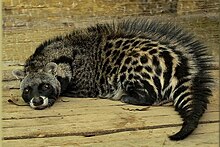Civet (perfumery)
Civet (Zibeth; Zibet; Zibetum), also known as civet musk and civet oil, is the glandular secretion produced by both sexes of Viverridae species.
Production[edit]

A number of viverrid species secrete civet oil in their perineal glands, including the African civet (Civettictis civetta), large Indian civet (Viverra zibetha), and small Indian civet (Viverricula indica). Most civet is produced in African farms, where African civets are kept in cages for this purpose.[1][2] African civets typically produce three to four grams of civet per week. In 2000, civet sold for about five hundred dollars per kilogram.[3]
Civet is a soft, almost liquid material. It is pale yellow when fresh, darkening in the light and becoming salve-like in consistency. Its odor is strong, even putrid as a pure substance, but once diluted it is pleasantly and sweetly aromatic. It is prepared for use in perfumery by solvent extraction to yield either a tincture (10 or 20 percent), an absolute, or a resinoid.[1][2]
Composition[edit]
The chemical in civet oil that gives it most of its distinctive odor is civetone, at a concentration of between 2.5 and 3.4%. The oil also includes various other ketones such as cyclopentadecanone, cyclohexadecanone, cycloheptadecanone, and 6-cis-cycloheptadecenone. The animal scent is reinforced by the presence of smaller amounts of indole and skatole, which in African civet are present at a concentration of about 1%.[1][2]
Uses[edit]
Civet has a distinctly different odor from musk and was formerly a versatile ingredient of fine fragrances. It is being displaced by 5-cyclohexadecen-1-one (Ambretone) which is more easily synthesized.[1]
Civet absolute (CAS# 68916-26-7) is used as a flavor and in perfumery.[4][5]
Safety[edit]
The United States does not allow civets to be imported, as the species can transmit the SARS virus.[6] The US does however permit the importation of civet oil, as long as it has been treated to ensure it is noninfectious.[7]
Name[edit]
The name derives from the Arabic زباد zabād or سنور الزباد sinnawr al-zabād, civet cat (Viverra civetta), by way of Old Italian zibetto and Middle French civette and Ethiopian name ዝባድ (Zibad) .[8] [9]
History[edit]
The 10th-century Arab historian al-Masudi mentioned civet (zabāda) as a spice in his book Murūdj al-dhahab ('Meadows of Gold').[10]
Civet was among the many trade items that caravans, controlled by the Ghana empire, carried from the Niger valley to North Africa, including Ancient Egypt.[11]
References[edit]
- ^ a b c d Fahlbusch, Karl-Georg; et al. (2007). "Flavors and Fragrances". Ullmann's Encyclopedia of Industrial Chemistry (7th ed.). Wiley. p. 86.
- ^ a b c George A. Burdock (2010), "CIVET", Fenaroli's Handbook of Flavor Ingredients (6th ed.), Taylor & Francis, p. 326
- ^ Shalu, Tuteja (2000), Civettictis Civetta African Civet, Animal Diversity Web
- ^ George A. Burdock (2010), "CIVET ABSOLUTE", Fenaroli's Handbook of Flavor Ingredients (6th ed.), Taylor & Francis, p. 326‒327
- ^ Transparency List, International Fragrance Association, 2011, archived from the original on 2014-09-11, retrieved 2014-09-12
- ^ Bringing a Civet into the United States, Centers for Disease Control and Prevention, 31 October 2022, retrieved 26 February 2023
- ^ Bringing Animal Products into the United States, Centers for Disease Control and Prevention, 14 September 2022, retrieved 26 February 2023
- ^ "civet", Merriam-Webster Online Dictionary[permanent dead link]
- ^ F. Viré (1997), "SINNAWR", The Encyclopaedia of Islam, vol. 9 (2nd ed.), Brill, p. 653b
- ^ A. Dietrich (2004), "AFĀWĪH", The Encyclopaedia of Islam, vol. 12 (supplement) (2nd ed.), Brill, p. 42b
- ^ Willie F. Page; R. Hunt Davis, Jr., eds. (2005), "civets", Encyclopedia of African history and culture, vol. 1 (revised ed.), Facts on File, p. 58


 French
French Deutsch
Deutsch